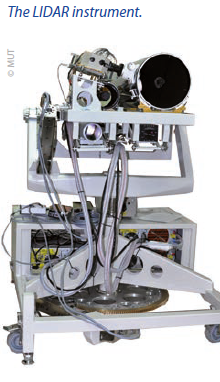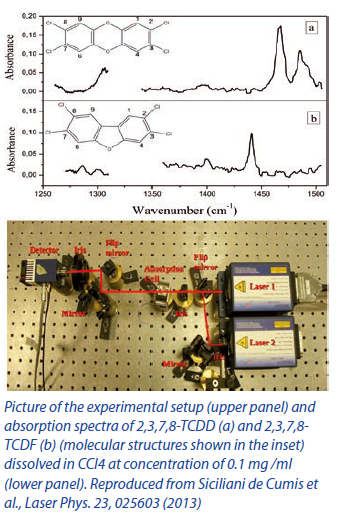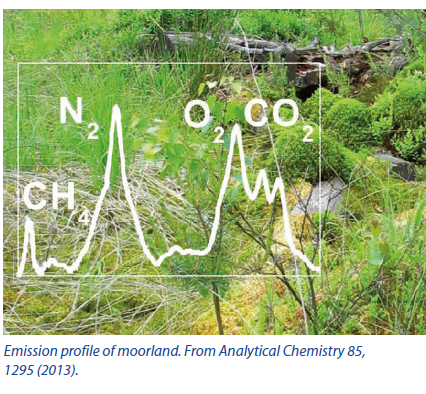Lasers for the Environment
A clean and healthy environment is of utmost importance for all living beings. ‘Nature is our life support system, so we have to look after it’, as the European Union puts it. Laser science can be used in many, very different ways to contribute to a better environment. By measuring toxins or biological agents, for example, or by studying microbes that might be used for soil cleaning. But lasers can also be instrumental in developing cleaner combustion processes. In this focus section, a number of projects from partners of Laserlab-Europe are presented that are beneficial, in one way or the other, to our precious environment.
ERC Advanced Grant for laser diagnostics of combustion processes (LLC)

In (partially) transparent combustion devices, laser light can be used to study the combustion dynamics and probe the presence of different chemical species in the flame with a high temporal and spatial resolution, without influencing the combustion process itself. Marcus Aldén has been using lasers for this purpose for thirty-five years. With his ERC Advanced Grant, Aldén will develop new diagnostic techniques and perform several phenomenological combustion studies.
One of the new techniques is spatially structured laser illumination of gases and fluids during combustion, which will allow instantaneous three-dimensional imaging of the combustion process by probing different sections of the flame using several differently structured laser beams. Another line of research planned by Aldén uses ultra-short laser pulses (of pico- and femtosecond duration), which cause the investigated gas mixture to act as a lens for the laser light, thereby creating a very thin channel of light, called a laser-filament. In this filament, a backward lasing effect might be induced, which would open up multiple diagnostic possibilities.
The combustion phenomena that Aldén plans to investigate include detailed flame studies at –industrially relevant – high pressure and turbulent circumstances, as well as the gasification and combustion of solid biomass – an emerging major technology yielding a CO2-neutral fuel for power, heat, and transport. Finally, Aldén and his team will use laser diagnostics to study electrically assisted combustion, where microwaves and discharge plasmas are employed to accelerate and control combustion processes.
Detecting hazardous particles in the sky with LIDAR (MUT-IOE)
LIDAR (Light Detection and Ranging) gains more and more attention in Poland due to the successful experiments carried out by the Institute of Optoelectronics (IOE) from the Military University of Technology, Warsaw, Poland. The researchers from IOE built a multifunctional fluorescence-depolarisation LIDAR system for stand-off detection of biological clouds at distances up to several kilometres. The efficiency of the LIDAR system was proved in a number of field tests, both in Poland and abroad.
LIDAR is not only able to distinguish biological particles from non-biological background, but also to classify the type of detected species. This is accomplished by the application of a hyperspectral detection approach combined with scattering/depolarization data fusion. Like fingerprints, the detected signals are compared with a database to find the closest match.
Bio-LIDAR was included in the security activities conducted by the Polish government during the European Championships in Football – EURO 2012. The system was installed on one of the top floors of the Culture Palace in the city centre of Warsaw and the air content above the National Stadium (located about three kilometres away) was continuously monitored during the games. Also, a miniaturised version of the “big” LIDAR system was created, capable of measuring at distances up to several hundred metres. It was also used during EURO 2012 to monitor the fan zone located directly beneath the Culture Palace.
The developed LIDAR system proved its high operational value during field tests at Dugway Proving Ground (DPG) in the USA, where full calibration, database optimisation and sensitivity verification were performed. The facilities of DPG allowed the measurements of biological aerosols dispersed at known concentrations to be carried out in specialised chambers. The LIDAR instrument, located 1200 m away, was able to detect 0.01 g of biological simulant added and mixed with air inside a buildingsized tunnel. This corresponds to an astonishingly low volume concentration level of several hundred ppl (particles per litre). Additionally, open air blind tests were performed, where the LIDAR system was scanning a certain angular range of terrain ahead and chased clouds to distances up to five kilometres. Simulants were released at unknown positions and moments of time, so the system operated in real-life conditions as an early warning component. It performed extremely well both in terms of detection and classification. Clearly, the LIDAR technology in Poland approaches readiness for commercial implementation.
Jacek Wojtanowski
IR spectroscopy of dioxins and furans with quantum cascade lasers (LENS)
Polychlorinated Dibenzo-p-Dioxins (PCDDs) and Polychlorinated Dibenzo-Furans (PCDFs) are ubiquitous and persistent organic pollutants characterised by extreme toxicity and widespread occurrence in the environment. In a collaboration with the Italian National Institute of Optics (CNR-INO), the European Laboratory for Non-Linear Spectroscopy (LENS, Florence, Italy) has been able to achieve a quantitative analysis of the concentration of several dioxins and furans, among which the most toxic ones, by only using infrared absorption laser spectroscopy.
Dioxins and furans are mainly produced by incineration of domestic, industrial and hospital waste, as well as by natural combustion processes. The possibility of realtime monitoring of these pollutants is therefore crucial to insure immediate counteractions in case of malfunctioning of incineration plants. Up to eight chlorine atoms can be placed on the two benzene rings, giving rise to 75 types of PCDD and 135 PCDFs. Among these 210 polychlorinated molecules, the 2,3,7,8-tetrachlorinated (TCDD) species have the highest toxicity. Two broadly tunable quantum cascade lasers (QCLs), emitting in the mid-infrared (MIR), have been used to measure the absorption spectra of dioxins and furans, dissolved in carbon tetrachloride (CCl4), in direct absorption mode. In the two considered MIR regions, 1260–1310 cm-1 (QCL1) and 1340–1510 cm-1 (QCL2), the absorption bands are located such that they are useful for identification of the different types of toxic chemicals.
The emission limit of dioxins for incinerator plants in Europe is set by law to 0.1 ng/Nm3. The laser setup shown in the figure allowed the measurement, among others, of the most toxic dioxin (2,3,7,8-TCDD). At present, the instabilities of the laser system do not allow to reach such limit but we proved that once the laser is stabilized, the condition to achieve the requested sensitivity is feasible. Moreover, we have demonstrated that using a hollow fibre instead of a normal liquid transmission cell, it is possible to further enhance the measurement sensitivity.
Barbara Patrizi and Mario Siciliani de Cumis
Discriminating between chiral pesticides (LaserLaB Amsterdam)
Around 30% of pesticides consist of so-called chiral molecules: they exist as two or more species (called enantiomers) that are non-superimposible mirror images of each other. Often, one of the enantiomers is much more toxic or less biodegradable than the other. In a recent transnational access project at LaserLaB Amsterdam in the Netherlands, published in Nature Communications, it was shown that a novel laser technique, called mass-selective photoelectron circular dichroism (MS-PECD), is capable of discriminating between different enantiomers.
Chirality matters a lot in Nature. Many enzymes only act on molecules with a specific handedness, while they ignore molecules that have a different chirality but are otherwise identical. This causes different enantiomers to have a significantly different impact on the environment. Because of their production process, pesticides used in agriculture often consist of equal mixtures of each enantiomer, of which only one targets the pests for which it was chosen, while the other chiral species might have an adverse effect on non-targeted organisms. Because pairs of enantiomers are so much alike, distinguishing between them is a challenging task. As has now been shown at LaserLaB Amsterdam, mass-selective photoelectron circular dichroism (MS-PECD) could provide a table-top solution for enantiomer-specific identification of chiral molecules in multi-component mixtures. The technique might therefore be used to study effects of chiral molecules and volatile organic compounds (VOCs) in different ecosystems.
MS-PECD is a special type of mass spectrometry, in which circularly polarised femtosecond laser pulses are used to ionise chiral molecules with multiple photons. By carefully combining information about the time it takes for the ions to travel to one detector and about the direction in which the electrons are ejected (registered by a second detector in coincidence), the molecular species as well as the ratio between both chiral varieties can be deduced. The access experiment was a collaboration between Ivan Powis from the University of Nottingham, who had already demonstrated the principle using synchrotron radiation, and a team from Amsterdam led by Maurice Janssen. The latter recently left his position as a professor at Laser- Lab Amsterdam to focus on the commercialisation of the MS-PECD, which would also have applications in pharmacy and the food sector.
www.laserlab.vu.nl www.massspecpecd.com
Microbes for natural cleaning (CLF)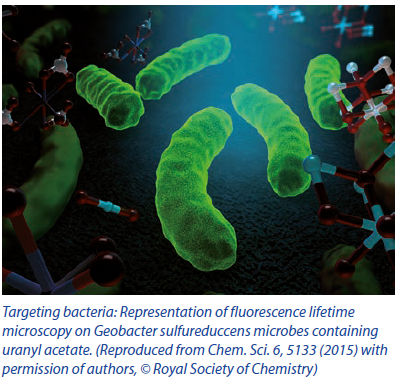
Micro-organisms might be able to help convert toxic waste to harmless chemicals, or could be used to prevent radioactive materials from spreading in soils. Several research teams are using the equipment available at the UK’s Central Laser Facility to find out how microbes could help clean the environment.
Using the Raman optical trapping capability, single bacteria can be captured and the Raman spectrum obtained to provide a finger print of the chemical make-up. The technique has been used by a team led by Professor Wei Huang (University of Oxford) to identify which species of bacteria digest specific compounds by analysing peak shifts from the incorporation of chemical isotopes. The technique offers the potential to determine strains of bacteria that can break down and bio-remediate specific pollutants. Simple microfluidic devices are used to enable sorting of bacteria species using laser-based manipulation techniques.
Another team of scientists from Manchester University, headed by Dr Louise Natrajan, is using facilities at the Central Laser Facility to investigate how microbes can help prevent radioactive waste materials from spreading in soils. Certain micro-organisms, such as bacteria, fungi and algae, can bind and accumulate radioactive material through biosorption. There are some strains of bacteria associated with soils that are capable of facilitating a chemical reaction whereby the radioactive material no longer dissolves in water. Such behaviour can markedly alter transport of this waste in the environment. At the Central Laser Facility laser-based imaging techniques are used to monitor the properties of uranium compounds in bacteria to provide fundamentally important information on both the microenvironment and chemical reaction processes. Lasers are used to target individual bacteria that are imaged using techniques of fluorescence lifetime and phosphorescence lifetime imaging. The results from the team’s most recent studies suggest that localisation of uranyl species (oxidised uranium) on both the cell membrane surface and outside of the cell play an important role during early stages of the bioreduction.
Andy Ward
Raman laser spectroscopy for environmental monitoring (IPHT)
At IPHT Jena, Germany, Torsten Frosch’s ‘spectroscopic sensors’ group develops laser spectroscopic setups for highly sensitive Raman multi-gas sensing. With the help of novel optical hollow fibres and optical cavities, strongly enhanced sensitivities are achieved for environmental monitoring, as well as for analysis of disease biomarkers in breath. The applications of this novel laser Raman spectroscopic developments are of importance for studying, for example, the impact of climate change.
As the Earth’s temperature rises, part of the permafrost in Siberia and other regions will melt, thereby releasing huge amounts of methane and other greenhouse gases. Raman gas spectroscopy could be used to measure in real time the emission of O2, CO2, CH4 and N2 from thawing permafrost, as was shown in a study where the concentrations and fluxes of these biogenic gases were measured in the head space of water-saturated, raised peat bog. In order to determine important ecosystem parameters such as the maximum photosynthesis rate and plant respiration, the peat bog was exposed to various light regimes. In a different study, the respiratory quotient (the amount of CO2 released per O2 consumed during respiration) of pine and spruce trees was monitored by cavityenhanced Raman multi-gas spectrometry. Real-time measurements of the respiratory quotient give excellent insight in how plants cope with stress factors such as drought and shading, but because the gas exchange fluxes are very small, this analysis had so far been very challenging.
Another important application is in monitoring resource flows in plants using the carbon dioxide isotope 13CO2, which is taken up by plants from the air during photosynthesis. As was shown in an experiment on poplar trees, since the carbon isotope 13C can be distinguished by cavity-enhanced Raman spectroscopy, the journey of these atoms through the entire plant can be tracked. This new technique thus adds a valuable new tool for the study of metabolism, from the scale of organisms to ecosystems.
Using lasers to study combustion (LLC)
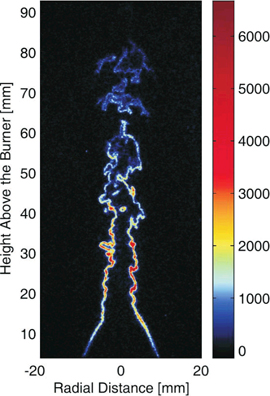
Currently, over 90% of the energy we use for transport, heating, and electricity production is generated by burning fuels. Considering that combustion emissions also constitute the main source of air pollutants, understanding the combustion process is crucial. Not only to enhance the efficiency of energy generation, but also to reduce the amount of pollution resulting from burning (fossil or renewable) fuels. Prof. Dr. Marcus Aldén, who heads the Combustion Physics Group of Lund Laser Centre in Sweden, has used lasers to study the details of combustion processes since the late seventies. He recently received an Advanced Grant of 2.5 million Euro from the European Research Council, to extend his research in this highly relevant field.
Lasers provide a convenient non-intrusive technique with which the combustion process can be followed with high spatial and temporal resolution, says Marcus Aldén. At Lund University, he collaborates extensively with combustion engineers, who operate over ten engines specially equipped with transparent windows – allowing laser beams to perform their diagnostic tasks. "We also have a high pressure burner which occupies a building of its own, and which operates at near industrial conditions. The laser measurements we perform in this burner provide a database that is used by modelers we cooperate with." Part of Aldén's research is concerned with rather fun- damental physics and he stresses that being part of the Lund Laser Centre is an important complement to the more industrial com- bustion connections. "We try to find out what will happen with atomic and molecular spectra at tem- peratures of 3000 Kelvin and pressures of 50-60 bars. It is a highly demanding task to under- stand the influence of these extreme conditions on non- linear spectroscopic tech- niques, but it is important since those conditions may prevail in actual industrial gas turbines or engines." The Swede collaborates closely with several industrial partners, but it is hard to find funds for the fundamental research needed to analyse combustion processes. "That is why I am particularly happy with this European grant."
Due to turbulence, the conditions in the combustion flame vary rapidly in time and from one place to another. Therefore, it is important to obtain a spatial resolution higher than the typical length scale of the turbulence, which is of the order of micrometers. Furthermore, variations in temperature, density and species concentration occur on a microsecond time- scale. "So far, we used mainly nanosecond laser pulses, which are short enough, but due to the low repetition rate of the lasers, we had to wait 100 ms between each shot. In the mean time, the conditions at that particular point in the flame will have changed." For that reason, Aldén will invest part of his Advanced Grant in new 'high rep-rate' laser systems.
Another important line of research comprises several types of infrared spectroscopy. Many of the chemical species present in the flames – mainly small molecules, such as water, carbon dioxide, methane, and ethane – hardly absorb light from both the ultraviolet and visible part of the spectrum. Aldén is planning to extend his work on polarization spectroscopy, a method in which the absorption is measured at the spot where two laser beams cross, into the infrared domain. "So far, people have only performed line of sight measurements in the infrared, which is of limited use when temperature and species concentration may change in space and time."
Infrared spectroscopy can be used to detect species, e.g., hydrochloric acid, and hydrogen cyanide, which are present in the flame in low concentrations but have strong absorptions in the infrared. These species play crucial roles in some types of combustion. Finally, Aldén would like to take his research to higher dimensions: "We will also do 2D measurements using an unfocussed probe beam crossed by a sheet shaped pump beam, to create a 2D image of the specific flame species probed.“


